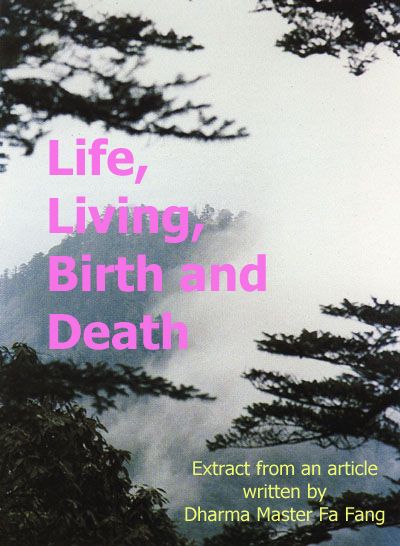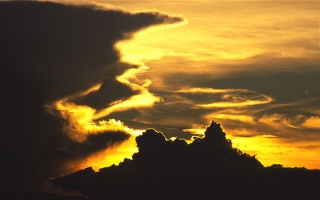
|
 |
|
What is human life? While there are many different answers and explanations, I am assuming that there are three definitions, as follows: The first is the life of human beings; the second is the life of human living; the third is the life of the cycle of the birth-and-death of human beings. If we have life, then we shall have living; if we have living, then we shall have the cycle of birth-and-death. Therefore, the three, namely life, living and birth-and-death, are one substance. Life is the continuation of human beings. Living is existing in the activity of life. Therefore, since we wish human life to continue, we must then seek something to support living, which is the condition of living in the present: clothing, food, shelter and various activities. The Ancient Master said, "Food and sex are the two fundamental elements of human nature." Sex is the nature of living as male and female to mate in order to seed generation after generation of descendants. There are two kinds of food: The first is material and constitutes eating and drinking to nourish the body to preserve and continue life; the second is intellectual and spiritual-that is, seeking knowledge and learning about culture. This is a very important condition of human living. Ordinary people only seek living but do not pay much attention to their lives. If one has more and higher knowledge, he may, besides merely seeking living, also seek the intellectual and spiritual contents of life; but he may not pay much attention to the cycle of birth-and-death and may even fear talking about it.
Let us now talk about human life. Some people are happy while others are not. Those people who have happy lives consider their lives to be meaningful. They are optimistic. Oppositely, those who are not happy with their lives consider their lives to be meaningless. They are pessimistic. Such considerations to label their lives as being happy or not happy depend strictly upon the material elements. Such people are materialistic. They are steered by the outside environment and its things. Since they are not satisfied with what they have now, they remain forever unhappy. They will never be satisfied with what the environment surrounding them offers nor with the material objects they possess. From the viewpoint of a Buddhist, however, both of these views are wrong because they do not consider the deeper meaning of human life. In Buddhism, then, there is neither optimism nor pessimism. The Buddha, the Enlightened One, has told us that both optimism and pessimism are wrong because they are both forms of prejudice. Thus, his teaching followed the Middle Way and, furthermore, gave Indian society correct instruction, which guided his followers to the Right Way. Ordinary people talk only about life in this world. They have no interest in searching for the origin of life, the future of life, or the meaning of life. Buddhists, however, have an active interest in investigating all these topics. If you want to know and understand the problems of human beings, you should know and understand the problems of the universe because the universe contains everything that Buddhism calls Dharma. Philosophers focus on this topic when they discuss ontology. Buddhism also discusses the dharma of the universe in three categories: (1) ontology; (2) phenomena; (3) relationships among phenomena. Together, these constitute conditional causation. Buddhists consider that everything arises from conditions and that nothing, no matter whether it is spontaneous or self-contained, has a separate and independent nature. Let me clarify what caused the universe to arise in terms of conditional causation, for which even Buddhists have many different explanations. Now, however, I only want to consider two of them: the causation of Karma and the causation of Alaya consciousness. Karma is caused by the action of human beings, and karma has some kind of power because it, in turn, further influences human action. Referring to the causation of Alaya consciousness, the School of Mere Consciousness asserts that the mentalities of all human beings have eight consciousnesses. The five senses (five organs) produce the first five consciousnesses; the sixth is mind consciousness; the seventh is Manas (the active mind) consciousness; and the eighth is Alaya consciousness. Alaya consciousness, which means store consciousness, can and, indeed, does contain and store the seeds of all things. These seeds are the causes, which, sooner or later, produce the fruits (effects). Thus, there are both good and evil seeds stored in the Alaya consciousness, which, sooner or later, retributively crystallize as suffering and happiness in the world. This, then, is the Alaya consciousness.
In short, everyone has life and spirit-that is, consciousness. According to the above explanation, this kind of life is produced by many conditions, and without those conditions there would be no self. Therefore, the life of human beings is without a beginning or an end, is impermanent and, also, without self. This, then, is the Buddhist view of human life. There are two views of human life, one of which, as I have said earlier, is profound. How so? Just because human life fills every part of in the world, and conditions and results interact with and complete each other. Thus, one is all and all is one! This is an incalculable world just like the number of sand grains in the Ganges River. Likewise, even though human life is very short, it is also very long. That life, as I have said, is without beginning or end actually means that life is endless and interminable. It is infinite! If so, then why do we need to seek longevity? Taking the view of neither beginning nor end, however, you should not think about the past and the future. You should take care of the present, and alert yourself to what are you doing now? Are you doing good or evil? Using the worldly view, look at life as short but also as great and meaningful. |
 Chinese
philosophy holds life to be extremely important. Taoism directs us to
seek longevity and cultivate ourselves for long life. Confucius (551-479
B.C.E.) said, "Maintain your life!" Western philosophy also
considers living to be important but seeks mainly material enjoyment.
All the wonderful innovations of the great material civilizations are
directed at improving life for all, and even the great wars were fought
for the betterment of our lives. Indian philosophy, however, considered
birth-and-death to be important and, therefore, sought the way to solve
the problems of the cycle of birth-and-death. This point of view is
also clearly detailed in the Svetasvatara Upanishad. The Buddhist
philosophy as reflected in both the Mahayana and the Hinayana schools,
considers transcending everything worldly and materialistic and attaining
holiness like that described in the Dharmas of the Three Vehicles, which
are important because they describe the ending of the cycle of birth-and-death
and how to arrive at that stage.
Chinese
philosophy holds life to be extremely important. Taoism directs us to
seek longevity and cultivate ourselves for long life. Confucius (551-479
B.C.E.) said, "Maintain your life!" Western philosophy also
considers living to be important but seeks mainly material enjoyment.
All the wonderful innovations of the great material civilizations are
directed at improving life for all, and even the great wars were fought
for the betterment of our lives. Indian philosophy, however, considered
birth-and-death to be important and, therefore, sought the way to solve
the problems of the cycle of birth-and-death. This point of view is
also clearly detailed in the Svetasvatara Upanishad. The Buddhist
philosophy as reflected in both the Mahayana and the Hinayana schools,
considers transcending everything worldly and materialistic and attaining
holiness like that described in the Dharmas of the Three Vehicles, which
are important because they describe the ending of the cycle of birth-and-death
and how to arrive at that stage. According
to Buddhism, life has no beginning and no end, which can be compared
to rushing water in a river, which never stops but ever changes. From
the time out of mind, life has changed moment after moment, like rushing
water in a river, never stopping but ever changing. Furthermore, things
in the universe are, also, like birth and death, never stopping, but
ever changing. The cycles of birth-and-death, change after change, are
called the stream of life. These cycles of birth-and-death, which
are always and ever changing, are known as impermanence. If all
things in the universe were permanent and never changed, then there
would be no progress in the world, no need to improve our circumstances
and lives, no need to talk about the end of birth-and-death,
no need to transcend the worldly to attain holiness, and no need
to do good and practice Buddhism. However, because there is neither
a beginning nor an end and because everything is impermanent, then we
have time to learn and to make some progress.
According
to Buddhism, life has no beginning and no end, which can be compared
to rushing water in a river, which never stops but ever changes. From
the time out of mind, life has changed moment after moment, like rushing
water in a river, never stopping but ever changing. Furthermore, things
in the universe are, also, like birth and death, never stopping, but
ever changing. The cycles of birth-and-death, change after change, are
called the stream of life. These cycles of birth-and-death, which
are always and ever changing, are known as impermanence. If all
things in the universe were permanent and never changed, then there
would be no progress in the world, no need to improve our circumstances
and lives, no need to talk about the end of birth-and-death,
no need to transcend the worldly to attain holiness, and no need
to do good and practice Buddhism. However, because there is neither
a beginning nor an end and because everything is impermanent, then we
have time to learn and to make some progress.